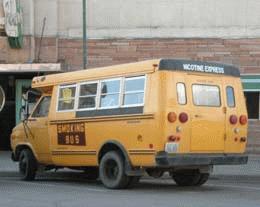On December 8, 2005, a new anti-smoking law goes into effect in Washington state, banning smoking in all public places and work areas and requiring people who light up to stay at least 25 feet away from doors, windows, and vents leading to such spaces. Officially titled the Smoking in Public Places Act, the law is the most restrictive yet to be adopted by any state in the nation.
The law was created by Initiative 901, which the state's voters approved by a margin of nearly two to one in November 2005. It replaced a 1985 statute that restricted smoking in most public buildings but permitted it in designated sections in restaurants and on the general premises of bars, bowling alleys, skating rinks, and other entertainment-oriented businesses.
In 2003, the Legislature considered but rejected two bills that would have banned indoor smoking in the few remaining places where it was still legal. Frustrated by the Legislature's failure to act, the American Cancer Society and other health groups took the issue directly to the voters two years later. Initiative 901 sailed to an easy victory, winning 63.2 percent of the votes cast.
The new law prohibited smoking in virtually all buildings open to the public in Washington state, with the primary exception of casinos on Indian reservations (which are exempt from state law). Also, up to 25 percent of the rooms in a hotel or motel may be set aside for smokers.
The most controversial provision was that which established a smoke-free buffer zone of 25 feet -- defined as a "presumptively reasonable minimum distance" -- around public buildings. Property owners could attempt to "rebut" the 25-foot rule by proving to the local health department that an exemption would not result in any smoke filtering into the building. Those who allowed smoking on their premises or near entrances to the buildings were subject to fines of $100 for each violation.
Reunification; Isolation
The law took effect on what the Seattle Post-Intelligencer described as "a day of reunification for some, isolation for others." Restaurants removed barriers that had previously marked the borders of smoking sections. Bar owners took tape measures and chalk outside to mark off "puffer zones." Ashtrays disappeared from view. "It's really making us criminals," one smoker told the Post-Intelligencer, while lighting up in front of the entrance to the Pike Place Market. She added that she was "kind of glad" about smoking being banned indoors. "But out in the air in public? It's kind of ridiculous."
Outdoors, smokers huddled in makeshift shelters like the "Siren Smoke Shack" -- a 12-by-20-foot aluminum carport set up behind the Siren Tavern in the SoDo district of Seattle, equipped with a propane heater, ashtrays, and a wooden plank for people to set their drinks on. A well-worn couch, an end table, and a folding chair briefly appeared in the median of Fremont Place North in Seattle, with a small white picket fence and a sign designating the "25-ft Lounge." Police quickly dismantled the "Lounge."
In Ritzville (in Adams County about 190 miles east of Seattle), Walter Foley, owner of the Whispering Palms Bar, turned an old yellow school bus into a "Nicotine Express Smoking Bus," parked outside his bar. Foley removed 18 seats from the bus, replaced them with lounge chairs, and turned the bus into a refuge for his customers. "It's my private vehicle," said Foley, 54, a smoker of Marlboro brand cigarettes for 40 years. "If they stop me from doing this, they're going to stop anybody in their private vehicle from smoking" (Northwest Herald).
Indoors, non-smokers expressed relief and satisfaction. "I'm so sick of waking up in the morning smelling like smoke," said one patron of Bergie's Bar and Grill in Seattle. "Now the only thing I'll wake up with is a hangover" (The New York Times).

